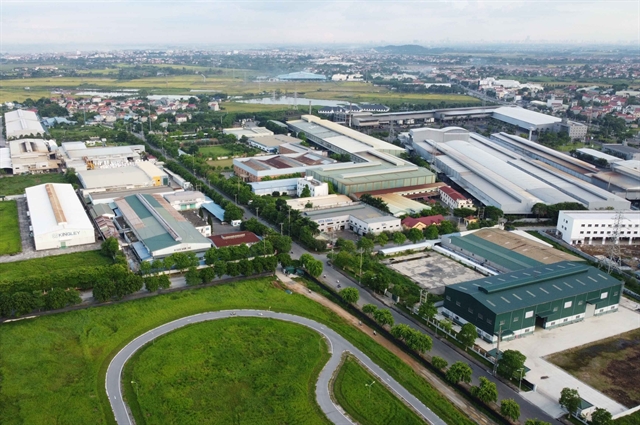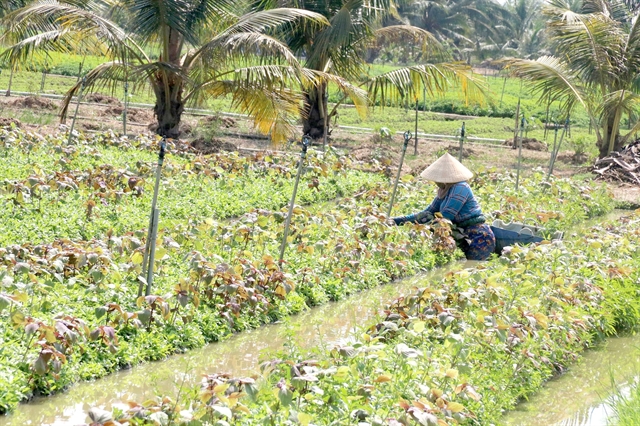 Society
Society


|
| Vegetable cultivation in Tiền Giang Province’s Gò Công Tây District. — VNA/VNS Photo Minh Trí |
TIỀN GIANG — The Cửu Long (Mekong) Delta province of Tiền Giang plans to expand rotation cultivation models for rice and other crops in its eastern area in an aim to improve productivity and cope with natural disasters, its Department of Agriculture and Rural Development has said.
The eastern area, which includes Gò Công Đông and Gò Công Tây districts and Gò Công Town, accounts for 28 per cent of the province’s total area and has advantages in fruit orchards and marine economy, but faces saltwater intrusion and drought in the dry season.
Nguyễn Văn Mẫn, director of the department, said the province plans to focus on growing more vegetables and other short-term crops to 2025 in the eastern area. Only two rice crops a year will be grown, while rice and other crops on rice fields will be rotated.
Under the plan, the province will transfer advanced farming techniques and encourage farmers to use Vietnamese good agricultural practices (VietGAP).
Co-operative groups as well as co-operatives will be expected to continue to work with companies to secure outlets for their members.
Gò Công Đông District, one of the major producers of rice and agricultural products in Tiền Giang, has 10 agricultural co-operatives that have contracts with companies.
This has helped secure outlets and provide stable incomes for their members.
Nguyễn Văn Nhẫn, director of the Tăng Hoà Agriculture Service Co-operative in Gò Công Đông District’s Tăng Hoà Commune, said the co-operative for many years has had contracts with companies to produce rice seeds and high – quality rice.
The co-operative produces high-quality rice on 50ha with an output of 250 tonnes a crop, he said. Companies purchase its rice at a price of VNĐ300 a kilogramme higher than the market price, he said.
The Tân Đông Clean Vegetable Co-operative in Gò Công Đông District’s Tân Đông Commune is growing clean vegetables on a total of 30ha with a daily output of 2.5-3 tonnes, using advanced farming techniques.
Trần Văn Bương, chairman of Tân Đông Co-operative, said the co-operative will encourage members to apply more advanced techniques to produce clean vegetables under VietGAP standards.
The co-operative will also encourage its members to expand the use of hydroponic farming, net houses and poly-green houses to grow vegetables.
Nguyễn Văn Qúi, head of the Gò Công Đông Bureau of Agriculture and Rural Development, said the district has two concentrated clean vegetable growing areas in Bình Nghị, Tân Đông and Tân Tây communes.
The two areas are guaranteed outlets by three agricultural co-operatives – the Bình Nghị Clean Vegetable Co-operative, the Tân Đông Clean Vegetable Co-operative and the Tân Tây Agriculture Service Co-operative, he said.
The three co-operatives have contracted with farmers to buy vegetables and later sell them to supermarkets and wholesale markets in and outside the province.
“Farmers in the concentrated clean vegetable growing areas now feel more secure about their products,” he said.
All communes in Gò Công Đông have agreements between companies, cooperatives and farmers to secure outlets for rice, vegetables and fruits for co-operative members.
To mitigate the impact of saltwater intrusion in the dry season this year, farmers in the eastern area have switched to growing vegetables or short-term crops on 2,700ha of rice fields that have problems accessing irrigation water.
In the ongoing 2020-21 winter-spring crop, farmers in the eastern area have planted more than 11,500ha of various types of vegetables and other short-term crops, which offer higher profit than high-quality rice, according to the department.
Farmers who grow leaf vegetables can earn a profit 2.6 times higher than that from high-quality rice. — VNS